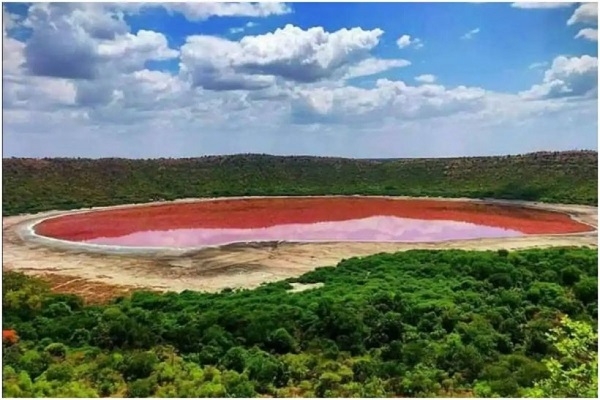50,000-year-old Famous Lake in Buldhana turns into Pink; Know what it is-
Total Views |
Buldhana, June 11: In a surprising phenomenon, in the past few days, the color of the water in Maharashtra's famous Lonar crater lake located in Buldhana district has mysteriously turned into pink from its usual greenish tinge with experts attributing it to the salinity and presence of algae in the water body. This nature's wonder is 50,000 years old.

For the past two-three days, the color of the lake’s water seems to have changed color. Forest department has been asked to collect a sample for analysis and find out the reason,” Lonar tehsildar Saifan Nadaf said.
Meanwhile, the forest department has been asked to collect a sample of water and dig out the reason behind the changing color of the lake. MN Khairnar, the deputy conservator of forests (wildlife), Akola, said, “We are observing this for the first time. We will collect samples of the lake water for testing to find the reason behind the occurrence. These samples will be sent to Neeri, Nagpur, and Agarkar Research Institute, Pune."
Experts say this is not the first time that the color change has happened, but this time it is more glaring. It is suggested that the probable reason behind the change of the water's color could be due to the growth of Halobacteria and fungus Salina. Also, a possible factor is weather change caused by the cyclonic formation and lowering of Lonar Lake's water level. Though, only experts in the field can get the correct reason.
For the first time in History.
— Amar Prasad Reddy (@amarprasadreddy) June 11, 2020
56,000 - Year old Lonar Lake in Maharashtra has turned Reddish Pink. What's the reason🤔? pic.twitter.com/q3kEUeYmeu
Gajanan Kharat, a member of the Lonar lake conservation and development committee, reportedly said, "There are algae in the water body. The salinity and algae can be responsible for this change." "The lake, which is a notified national geo-heritage monument, has saline water with pH of 10.5," he further added.
"There is no oxygen below one meter of the lake's water surface. There is an example of a lake in Iran, where water becomes reddish due to an increase in salinity," he noted. He attributed the change in color to the increased salinity in the lake due to lower levels of water as compared to the previous year and change in the behavior of algae because of atmospheric changes.
"The low level of water may lead to increased salinity and change in the behavior of algae because of atmospheric changes...this may be the reason for color change. This is not the first time that the color of water has changed,” he said.
Similarly last year, the inland lake at Westgate Park in Melbourne, Australia has also transformed into a shocking shade of pink. But Westgate Park’s fluorescent fuchsia hue is actually triggered by an all-natural process. Westgate Park is a salt lake and only switches to a pink color when salt levels are higher than normal.
About the lake:
It located around 500 km from Mumbai, the Lonar lake in Buldhana district is a popular tourist hub and also attracts scientists from all over the world. The Lonar Lake was formed around 52,000 years ago when a meteor weighing two million tonnes hit the Earth at a speed of 90,000 kmph and is the world's only saltwater lake in basaltic rock. It was identified as a unique geographical site by a British officer C J E Alexander in 1823, and also declared a notified National Geo-heritage Monument in 1979. It is one of the four known, hyper-velocity, impact craters in basaltic rock anywhere on Earth.
Lonar Lake, also known as Lonar crater is located in Buldhana district of Maharashtra which is formed due to the impact of a large meteorite. Lonar Lake is the largest saline lake in the world formed by the impact of meteorite.#GSI #Maharashtra #Buldhana #LonarLake pic.twitter.com/xlYCKfEug4
— Geological Survey of India (@GeologyIndia) January 7, 2020
The lake is reported to be highly alkaline in nature with a pH of 10.5 but is also unique for its high levels of salinity. The water of the lake is both saline and alkaline in nature, which makes it one-of-its-kind not only in India but also in the world. The strange geochemistry of such lakes enables the growth of specific types of microorganisms, some of which are not found. Lonar Lake has a mean diameter of 1.2 kilometers (3,900 ft) and is about 137 meters (449 ft) below the crater rim.

